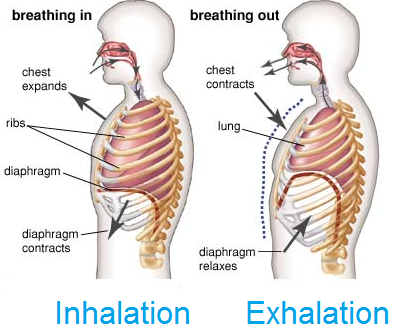Breathing


Breathing
Breathing is a physical process that sends fresh air/water (rich in ) to respiratory organs and removes foul air/water (rich in carbon dioxide) from them.
Breathing : The process of taking in and giving out air for respiration is called breathing. Breathing involves two main steps, inhalation and exhalation. During inhalation, we breathe in air which is rich in oxygen. During exhalation, we breathe out air which is rich in carbon dioxide.
During inhalation chest cavity expands with the help of the thoracic muscles and during exhalation muscles relax ad their occur decrease in the size of thoracic cavity.

Rate of Breathing:
When we do normal activities, the rate of breathing is normal. The breathe rate of human beings is 15- 18 breaths a minute. The rate of breathing increases when we do strenuous physical works such as running, swimming, jogging, etc. The rate of breathing decreases when we take rest or when we are sleeping.
At high altitude, RBC of human blood will _________________ | |||
| Right Option : A | |||
| View Explanation | |||
Consider the following statement about inhaled air and exhaled air: (i) Exhaled air contains more carbon dioxide than inhaled air. (ii) Exhaled air is cooler than inhaled air. (iii) Inhaled air contains more moisture than exhaled air. (iv) Inhaled air contains more oxygen than exhaled air. Which of the above statements are correct? | |||
| Right Option : D | |||
| View Explanation | |||
Students / Parents Reviews [10]
I have spent a wonderful time in Abhyas academy. It has made my reasoning more apt, English more stronger and Maths an interesting subject for me. It has given me a habbit of self studying

Yatharthi Sharma
10thMy experience with Abhyas is very good. I have learnt many things here like vedic maths and reasoning also. Teachers here first take our doubts and then there are assignments to verify our weak points.

Shivam Rana
7thAbout Abhyas metholodology the teachers are very nice and hardworking toward students.The Centre Head Mrs Anu Sethi is also a brilliant teacher.Abhyas has taught me how to overcome problems and has always taken my doubts and suppoeted me.

Shreya Shrivastava
8thBeing a parent, I saw my daughter improvement in her studies by seeing a good result in all day to day compititive exam TMO, NSO, IEO etc and as well as studies. I have got a fruitful result from my daughter.

Prisha Gupta
8thAbhyas Methodology is very good. It is based on according to student and each child manages accordingly to its properly. Methodology has improved the abilities of students to shine them in future.

Manish Kumar
10thAbhyas is a complete education Institute. Here extreme care is taken by teacher with the help of regular exam. Extra classes also conducted by the institute, if the student is weak.

Om Umang
10thMy experience was very good with Abhyas academy. I am studying here from 6th class and I am satisfied by its results in my life. I improved a lot here ahead of school syllabus.

Ayan Ghosh
8thIt was a good experience with Abhyas Academy. I even faced problems in starting but slowly and steadily overcomed. Especially reasoning classes helped me a lot.

Cheshta
10thIt has a great methodology. Students here can get analysis to their test quickly.We can learn easily through PPTs and the testing methods are good. We know that where we have to practice

Barkha Arora
10thOne of the best institutes to develope a child interest in studies.Provides SST and English knowledge also unlike other institutes. Teachers are co operative and friendly online tests andPPT develope practical knowledge also.
